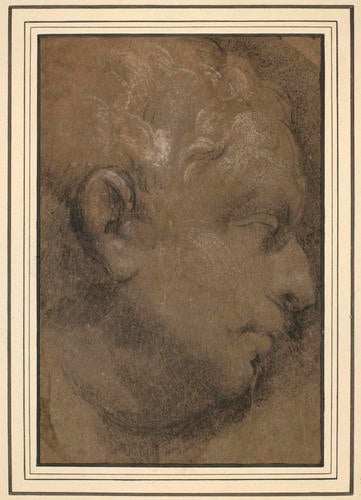-
1 of 253523 objects
Study of a bust of Vitellius, in profile c. 1560-80
Black chalk, with white chalk heightening, on brown paper | 27.8 x 17.6 cm (sheet of paper) | RCIN 905413

School of Jacopo Tintoretto (1519-94)
Study of a bust of Vitellius, in profile c. 1560-80
-
This drawing in black and white chalk is a study of a portrait bust of the Roman Emperor Vitellius (15-69 AD). Though attributed to the school of Carracci in an inventory taken of the Royal Collection in 1810, the drawing has been since recognised as by a Venetian hand. Martin Clayton has suggested it was a produced by a member of Tintoretto’s workshop.
A cast of an antique bust of Vitellius was used in Tintoretto’s workshop, where drawing after sculpture was a significant practice. The numerous studies of the bust produced by Tintoretto and his students suggest that it functioned as a training tool. In Drawing in Tintoretto’s Venice (2018), John Marciari proposes that Tintoretto’s students based their drawings both on the bust itself and on previous studies created by Tintoretto. This suggestion could be borne out in this study, which has the flatness of a copy rather than the more distinct three-dimensionality of a study drawn from observation.
The bust of Vitellius was discovered in Rome around 1505, and was sent to Venice by the Cardinal Domenico Grimani in 1523. From 1525–93, the bust was displayed in the Doge’s palace where artists could study and make casts from it. Given the scarcity of classical statuary in Venice, the Grimani Vitellius became an important reference point for sixteenth-century Venetian artists, who regularly used it as a model for figures in their own works, or as the subject for studies. In an article for the Getty Museum Journal, Vol.5 (1997), Stephen Bailey provides an overview of the many drawings and paintings based on the bust.
Further studies of the bust held with the Royal Collection can be found at RCIN 990837 and 906702.
The upper corners of the sheet have been clipped, and infilled at a later date. This is a common feature in drawings that were in England in the late seventeenth century, though it is not known whether this was the favoured mounting style of one unidentified collector, or a more general fashion.Provenance
Royal Collection by c. 1810; listed in George III's 'Inventory A,' c. 1800-20, p.19: ’10 school of Caracci’.
-
Creator(s)
-
Medium and techniques
Black chalk, with white chalk heightening, on brown paper
Measurements
27.8 x 17.6 cm (sheet of paper)
Category
Object type(s)